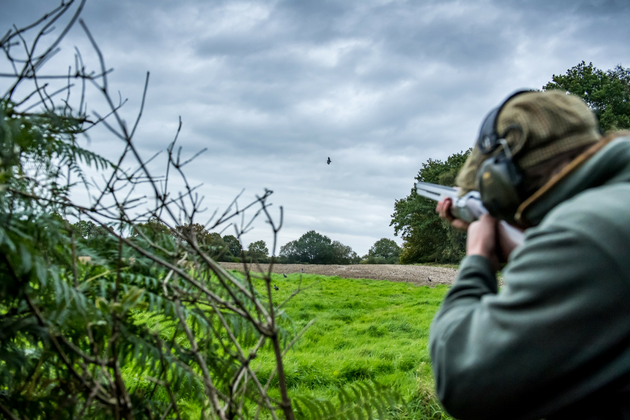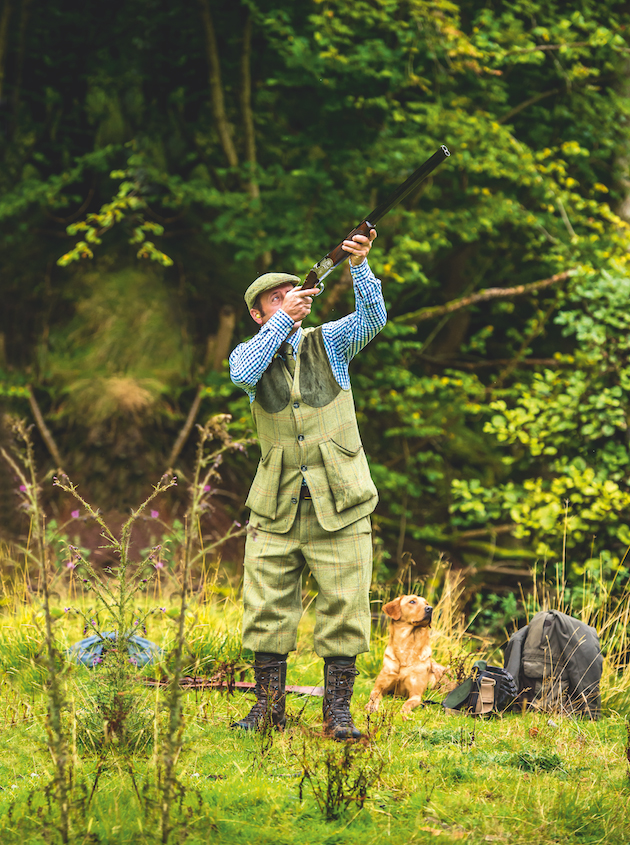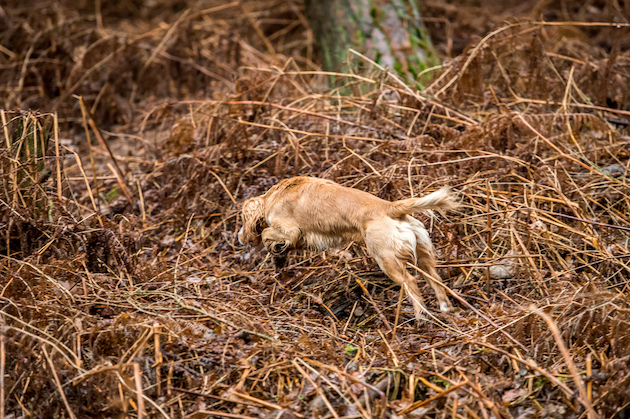How to humanely kill a bird
There are occasions out in the field when pheasants, partridges, ducks or pigeons are pricked (meaning wounded) so knowing how…
Win CENS ProFlex DX5 earplugs worth £1,149 – enter here
It’s not always easy to spot a wounded bird — and it may fly on for some distance after being shot — so do keep your eyes peeled, advises Ian Grindy

Accurate marking of birds is essential for a number of reasons.
First, while we all try to achieve a swift and humane kill, it is inevitable that you will on occasion wing a bird. If a bird is well marked, the process of promptly retrieving and humanely despatching it is much quicker, which should be imperative. (Read more on how to humanly kill a bird that has been pricked.)
Secondly, we are in the food business. Each bird we shoot is destined to be eaten. Much nonsense is made of the ‘respect’ we show our quarry through donning a tie and a natty suit when we shoot it. To my knowledge game birds are fairly indifferent about neckwear and tweed, but I see no greater contempt for the noble partridge or pheasant than leaving him to rot in a ditch because, rather than marking his fall and getting him in the game bag, your attention is focused on shooting another of his fellows.
I will start with the most elemental form of hunting with a shotgun — rough shooting. You are largely walking-up, so you are shooting at going-away birds. For a few years I was a member of a small walked-up syndicate in the Brecks. The shoot was a square of arable surrounded by blocks of Scots pine and beech with an almost impenetrable understorey of Oregon grape and bramble.

Always watch a bird die before moving on to another
Snap-shooting for pheasants and woodcock was the order of the day. Any hesitation and birds simply jinked away like wraiths into the wooded gloom to your front. If, however, you achieved a smooth gun-mount and crisp trigger pull as soon as a bird flushed, it was possible to connect with one or two. They were infrequently high and usually way out in front. Bags rarely made double figures but it was huge fun.
Marking pricked birds was doubly challenging. When shot they tumbled away from you, becoming lost to sight behind a tree on their way down. And a shot bird invariably landed within the web of jagged understorey or disappeared into one of the flint pits that betrayed the landscape’s Neolithic past.
Marking birds was very much a matter of fieldcraft and common sense, not to mention a reliance upon a dog with a decent nose. The Guns halted whenever a bird was shot, the line on which it had fallen was indicated and a single dog was sent to hunt that line. This avoided fouling the scent, which can occur in a canine free-for-all. Very few birds were lost and we all enjoyed watching the dog work. When bags are small, every bird is precious and an unpicked one was treated as a communal failure.
Away from the rough and tumble of walked-up shooting, driven grouse days require a different approach. I recently wrote about my experiences as a beater on a moor in County Durham. On this particular shoot, thanks to its long and thin topography, all the picking-up was done by the beating line, rather than having a picking-up team behind the butts.
One of the experienced hands I met there told me that on double-gunning days Guns will occasionally carry a marker disc, known locally as a ‘Majora’, on which they, or their loader, will scrawl down an X to mark the point where each shot bird falls. On the day I tramped the moors, the Guns were shooting single, marking their own birds purely by memory.
This is no easy task when you consider that with a tail wind a grouse is hitting 80mph. Shots are taken out in front and momentum carries the fallen over the Guns’ heads to land well behind. Some of the information received at the end of each drive tended to be rather general as to the locus of shot birds. Fieldcraft came into play here and feathers caught upon the heather tops helped to guide us.
Then a number of trusted retrievers were sent out to cover the area. It was testament to this concerted mark and sweep that not one bird went unpicked.
Away from the uplands, marking birds on driven pheasant and partridge days presents its own challenges. Due to the sort of days I shoot on, I never find myself having to remember where the umpteenth bird I shoot has fallen but I have certainly had my memory tested while picking-up.
It is certainly not easy to keep track of where every bird lands but certain techniques can be very helpful. I try to use two conspicuous points of stationary reference as an aide-memoire, thereby creating a triangulation point between those features and me.
I have become rather accomplished at this, thanks in part, I believe, to my writer’s eye. When I arrive at my peg I spend the time that I should use in preparing for the drive in noting memorable landmarks — such as an unusually shaped tree limb or a dangling gate made from an old bedstead. While I might be woefully unready for the shooting ahead, I do give dramatically accurate marks for the pickers-up.

Gundogs are a vital tool in the bird-marking arsenal
If we are prepared to shoot living creatures we must also be aware that we will not always achieve an immediate kill. Winged birds react in a variety of ways and it is important to learn how such unfortunates behave. As a general rule of thumb pheasants, particularly cock birds, hit the ground and run for cover while partridges, like grouse, often squat and hide where they land.
On one beaters’ day last year I had confidently marked a hen pheasant as winged but down in a thick hedge that covered a ditch. I pointed out the exact spot where I believed the hen lay to two of the pickers-up and was buoyed by the sight of a few feathers caught up in the dog rose that garlanded the hawthorn.
Despite repeated hunting up and down the hedge no dog could find my bird. I started to doubt not only my method of marking, but also my sanity.
It wasn’t until the keeper’s dog started marking some 100 yards back along the ditch line that we realised the hen had indeed gone into the hedge, found a land drain and scuttled along its length, arriving at the far end precisely where the keeper’s Labrador was now marking.
Birds that you see steepling skywards are invariably hard hit and dead in the air, resulting in a straightforward retrieve. It is the lightly pricked bird that sets its wings and glides out of sight into a neighbouring wood that produces the biggest marking challenge.
In this instance it is best to mark the line it has followed, using the triangulation method. You may well not see it land but at least you have some inkling of the lateral line upon which you and your dog can begin your search.
Finally, don’t forget the other vital tool in the bird-marking arsenal — your dog.
There are occasions out in the field when pheasants, partridges, ducks or pigeons are pricked (meaning wounded) so knowing how…
If it’s your first time out, then your fellow beaters and pickers-up will show you the ropes. In the meantime,…
My height helps me spot where a shot bird might actually land. However, when my dog Mabel’s sharp eyes see a pheasant fall or a pigeon plummet it gives her additional impetus when sent out to retrieve. A dog’s eyesight is a much debated topic, but from my own observations I am confident they know the difference between a flying bird and one that is shot. Guns will wax lyrical about their dog’s scenting abilities, yet rarely boast about their binocular eyesight. I am proud of Mabel’s hawk eyes.
Marking birds is indeed an art — largely of the school of realism but with the odd daubs of abstraction.
Get the latest news delivered direct to your door
Discover the ultimate companion for field sports enthusiasts with Shooting Times & Country Magazine, the UK’s leading weekly publication that has been at the forefront of shooting culture since 1882. Subscribers gain access to expert tips, comprehensive gear reviews, seasonal advice and a vibrant community of like-minded shooters.
Save on shop price when you subscribe with weekly issues featuring in-depth articles on gundog training, exclusive member offers and access to the digital back issue library. A Shooting Times & Country subscription is more than a magazine, don’t just read about the countryside; immerse yourself in its most authoritative and engaging publication.

